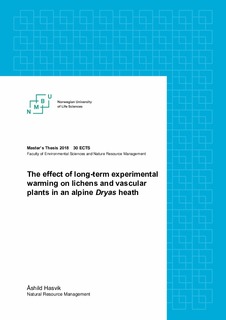| dc.description.abstract | Global warming affects species diversity and ecosystems throughout the world, and alpine and arctic plant communities are considered to be particularly sensitive. During the last decades, several studies have shown a shift in species composition and a movement of species to higher elevations. Long-term warming studies have been conducted in these areas, with the aim to better understand and predict how consequences of global warming will affect the flora in cold climate ecosystems.
In this thesis, I have collected data from an on-going, 17-year-old, warming experiment in an alpine Dryas heath at Finse, Norway. I wanted to analyse how warming has affected species cover and richness of lichens and vascular plants and to assess if species composition of lichens and vascular plants has changed. Furthermore, I examined the role of soil moisture and cover of the dominant dwarf shrub Dryas octopetala on species cover, species richness, and composition. To examine if species cover and species richness differed between warmed plots and control plots I used one-way analysis of covariance (ANCOVA) with soil moisture and cover of D. octopetala as covariates. To visualise community composition in relation to the warming experiment I used ordination analysis.
I hypothesised that experimental warming would lead to a decrease in lichen richness and species cover, at the expense of an increase in species richness and cover of vascular plants. I found some support for the hypothesis, however, the majority of the results showed no effect of the warming manipulation. Few significant results may indicate stability in the community at Finse, and the ability to tolerate small changes in temperature. Possible explanations for stability is the influence of the dominant dwarf shrub D. octopetala and climatic conditions in Norway with a high level of precipitation that could counteract the effects of warming. | nb_NO |

